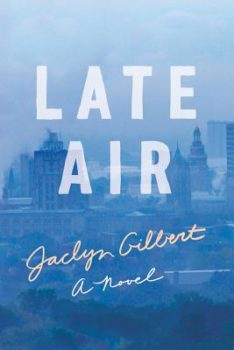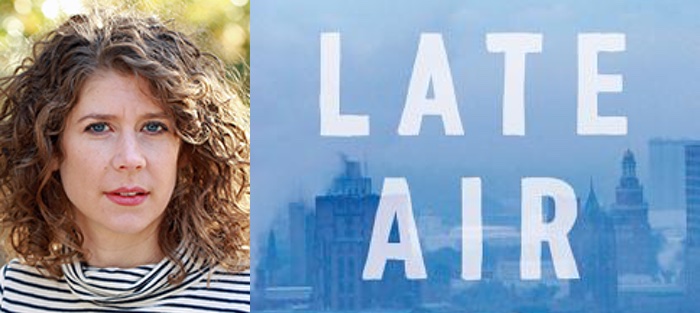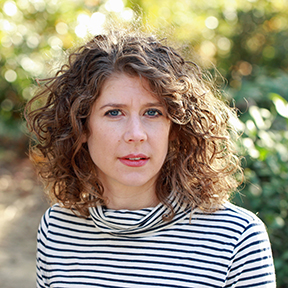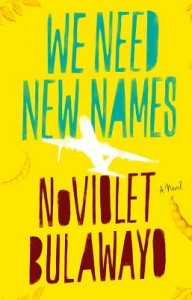Jaclyn Gilbert’s novel Late Air (Little A) is a book full of accidents. Murray, a women’s cross-country coach at Yale, watches his star runner succumb to a serious head injury after getting hit by a golf ball during a run, and the loss of control sends him spiraling. His life’s other accidents resurface—meeting his wife Nancy, having a child, losing that child inexplicably. We understand these accidents and losses from two points of view: Murray’s and Nancy’s. They are an estranged couple moving through grief on separate timelines, dealing in their own ways with what it means to be at the mercy of something larger than oneself.
At one point, Nancy looks at an Agnes Martin painting and observes that “every single moment an artist has a choice about how she wants to look at her subject, and in an instant that decision can change, that choice can change, so in some ways we could consider the final piece an accident.”
I asked Jaclyn Gilbert if she sees her own art as an accident of choices, and she said, “I am convinced that the most telling moments are the ones we least expect. My best writing often arrives as a surprise, a kind of chance occurrence that I hope a reader will find compelling, too.”
Jaclyn and I met up in Brooklyn to discuss the themes of her debut novel, writing, running, and what she’s working on next.
Interview:
Shayne Terry: In many ways, this is a novel about perfectionism. Nancy and Murray have very different perfectionistic tendencies—Murray’s passed down from his demanding father and Nancy’s related to larger societal expectations—but it’s certainly an albatross for both of them. Did you set out to write a story about perfectionism?
Jaclyn Gilbert: As a runner, I’ve dealt with my own issues with perfectionism, and I think writing this book forced me to look at its dangers. For a while I thought perfectionism was a good quality, since so often it involves pouring every ounce of oneself into a goal or idea, but there’s definitely a limit to the obsessive mindset perfectionism breeds. If the right boundaries aren’t set, it can lead to self-injury.
In writing Late Air, I could identify with Murray’s perfectionism. He’s relentlessly focused on getting results, expecting the very best from his athletes and everyone else around him to the point of appearing overly judgmental and unfeeling. His ex-wife Nancy is a perfectionist, too. Nancy and Murray are obsessed with details, but in different ways. While their perfectionism is something they bonded over when they first met, it is also what divides them later, when they are unable to understand their separate needs for grieving.
There’s also this relationship at play in the book between perfectionism and anger, particularly female anger. Nancy gets so many messages from the people around her—Murray, her friends, even her therapist—that anger is bad. Murray calls her “crazy” and says she is “overreacting.”
Writing about Nancy made me question my own discomfort in expressing anger as a woman. Like Nancy, I often think things I’m too afraid to say, but then in keeping things in, I’m punishing myself and those around me, more often than not—because I’m not giving the truth room to breathe. Instead it just festers. But Nancy’s grief also takes the shape of anger, largely because her perfectionism hasn’t left her any room to cope with loss, especially one that has turned her world in reverse, and Nancy’s therapist Katherine’s need to box her grief into stages sends Nancy into a silent rage. The truth is that when we are grieving, we don’t know the order of the emotions we will feel, or how long they will last. The only way Nancy can recover is by opening herself up to the larger unknown of her grief and pain.
 Murray is an undeniably sexist character. He looks down on female running coaches. We get plenty of his male gaze on the women on his team, whom he calls “the girls” or “his girls.” He both likes and loathes the power dynamic that exists between them, noting how hard they work for his approval while thinking it makes them weak. In the end, though, he needs them. Having aged out of the sport himself, it is only through the women on his team that he will find success. How does it feel to take on a problematic male character in the era of #MeToo? Were there any special considerations you made?
Murray is an undeniably sexist character. He looks down on female running coaches. We get plenty of his male gaze on the women on his team, whom he calls “the girls” or “his girls.” He both likes and loathes the power dynamic that exists between them, noting how hard they work for his approval while thinking it makes them weak. In the end, though, he needs them. Having aged out of the sport himself, it is only through the women on his team that he will find success. How does it feel to take on a problematic male character in the era of #MeToo? Were there any special considerations you made?
I’ve always understood Murray as morally ambiguous—a reflection of the dangerous ways in which gender norms rely on binaries to order our thinking. On top of the masculine norms Murray is operating within, Murray learned to channel his pain by pushing himself and his athletes to their limits. On the surface, this makes him unsympathetic, particularly in the era of #MeToo, but in writing his character, I also knew I wanted his consciousness to be more about the inherently destructive nature of his identity. Not only does his silenced pain erupt out of him—he hallucinates and becomes unable to separate his perceptions from reality—but he also needs to project that pain onto his athletes. He can only continue on like this for so long. Eventually the system unravels, breaks down.
Nancy’s journey runs counter to Murray’s self-destructive path. She takes up running as a means to heal and forgive. You are also a runner. Can you speak to this kind of duality around running in your life?
What I realized much later in my writing process was that these characters symbolize two parts of myself. Through Nancy and Murray, I was navigating larger questions about my relationship to running. When I started Late Air, I was in a Murray mindset, obsessed with pushing my body and my writing to yield the results that I wanted. I had to come to terms with the fact that I couldn’t keep pushing myself to the point of exhaustion and, more often than not, injury.
As I continued to develop the story, especially Nancy’s journey to overcome her grief, my relationship to running changed. Just as Nancy’s arc is about finding compassion for herself and learning to ground herself in her body and sit in her pain, I had to learn to sit in my body, too—to check in with myself and acknowledge my physical and emotional boundaries as a runner and writer. Nancy taught me that being kind to myself and my body was a choice to be made—that I had to choose to step back and be patient enough to observe my own thoughts. When I did that, I could create the space to find greater compassion for myself, enough to transcend my fears and doubts, my past injuries, my fear of repeating pain.
Turning to your writing practice, this novel began as a short story. How did it evolve?
Five years ago, when I began my MFA, I was running along the Bronx River Parkway past a golf course and I imagined the moment of Becky’s accident. I trained on a golf course all through college, but the risks of an errant ball that might have hit me or one of my teammates haunted me during that run. I wrote the first scene of a short story that would later become the novel. The story was told from Murray’s skewed point of view but took place over a matter of weeks, and when I shared it with my fiction workshop, everyone wanted to know more about him.
I followed their curiosities throughout the program, and under the guidance of my thesis advisor David Ryan, I developed the story into a novella. David was excited about the final work and saw a future for it, and I am grateful for his belief because it helped me take the leap after graduate school and commit to making Murray’s story a full-length novel.
The process was painful. I had to accept that I would be rewriting and reworking most of the pieces that had seemed so central to the shape of the novella. I truly had no idea what a balancing act it would be, getting the pace to feel right and hooking in the reader chapter by chapter while still leaving room for the emotional underbelly that would allow for Murray and Nancy to feel like fully realized characters.
The book mostly takes place at Yale, but it evolves toward the end into a New York novel, when Nancy moves to the city for a fresh start. I’m curious about the ways in which you are attached to these two places, and how you landed on the setting of the novel.
I guess in many ways I am always writing about the running terrains most formative to my development as a young person. I can still vividly picture training on the Yale golf course in college, and this provided me not only a physical grounding, but also an emotional landscape of time and memory to draw from. New York is another formative space for my identity as a writer and runner. It was a place I navigated by running along the East and Hudson Rivers, around Central and Prospect Parks, crossing bridges and highways. These routes grounded me during life transitions as I pursued a career in writing and publishing, creating a kind of emotional map.
How much of your experience running at Yale made it into the novel? And how much research did you do for this book in general?
The running part of the book came most easily. It’s been so ingrained in my daily experience since I was thirteen. I went through a difficult period of my life at Yale. I lost my relationship with my father in a way I don’t think I’ll ever be able to fully understand or locate in words, and that’s why I need to write about it, even if abstractly in my fiction.
My running practices around the Yale campus punctuated this tumultuous time in my life. It’s a period full of anguish and pain, and I think constant running and exercise promised escape from the less tangible feelings of my loss. It’s also a time that fuels my imagination, a place my memory wants to circle back to, using language and plot to fill in the blank spaces.
But at the same time, much of what happens in the book didn’t actually happen to me—I was never injured on the golf course, nor have I ever coached young women runners, worked as a curator at a rare books and manuscript library, or had a child—I had to do a ton of research on the specific circumstances that made Murray and Nancy’s story true. I spent many months researching the elusive nature of Becky’s brain injury, the level of treatment she needed, and her recovery process.
The research I did on SIDS was the most heartbreaking. I read eight books about it, all stories of families who lost their babies for unknown reasons. I cried each time a mother described her journey through trauma and grief—her aching limbs, her struggle to breathe. Telling this story taught me how rarely we have control over the worst things that might happen to us. The only thing we have control over is how much we are willing to let go of our dreams, especially those we might have for the people we love. It’s the ultimate act of forgiveness, I think, this deciding to let go of how our lives might have turned out differently.
Tell me about your writing routine.
I wrote the whole first draft of the book by hand, on legal pads. I had this constant goal in my mind of getting to twenty yellow pages every couple of weeks. Some days I got three, others ten, but the point was sitting in my chair and writing toward a set goal.
I do a lot of commuting for my freelance work, and I learned to use pockets of train time to revise. I really enjoy writing on a moving train. It’s so impressionistic. One of my secret wishes is to do a writing residency on a train.
Being a writer has affirmed my belief that we are always transit, and the more I can create space for the transient and ever-shifting, the more the work feels full of possibilities—this sense of a constant becoming that drives me to keep going.
Who do you read for inspiration, and with which books is Late Air in conversation?
M. Coetzee’s Disgrace was a huge inspiration for Murray’s character—it influenced my vision for him as a man blinded by untenable dreams and false truths. Disgrace is also a story about trauma, asking big questions about how we move past historical atrocities. How do you both recognize and let them go as a means of moving forward? You can’t just say, “Now is the future, so let’s forget the past.” There’s always that same larger question of self-forgiveness to be dealt with, and we can’t do it alone; we have to be transported through other experiences, to reconcile with other memories and imaginings of the same events.
The Lover by Marguerite Duras is another book that really inspires me to keep grappling with these kinds of questions. Barbara Bray’s translation is really beautiful, circling trauma and language in a way that feels organic and whole.
I love James Baldwin, and I returned to him a lot during the writing of the novel, specifically Giovanni’s Room. For me, this novel perfectly captures the romance of Paris and the search for ideals that can’t be realized out of a post-colonial dream.
Can you share what you’re working on now?
My next project is a bit of a rebellion against Late Air, in that it’s told from multiple points of view in the aftermath of a trauma. I’m not explicitly locating that trauma in the narrative but instead am looking at its associative reverberations through a community. The novel takes place near where I grew up in Lancaster, Pennsylvania, along the borders between Amish country and the suburbs. My first experiences as a runner were on those backcountry roads, circling Amish farmland, so I have a deep connection to the setting.
The traumatic event the novel alludes to is a shooting that happened in 2006 in an Amish schoolhouse in Nickel Mines, Pennsylvania. A local milk truck driver took thirteen girls hostage. He shot some of the girls hundreds of times while leaving others unscathed, before shooting himself. The day it happened, the Amish publicly forgave the killer and his whole family. Most of the literature that came out of Nickel Mines is focused on Amish grace and forgiveness, but I can’t stop thinking about those girls who survived. How could they have processed their wounds within a strict religious community so set on quieting their story?
The novel explores the inner life of a survivor named Emma who works in the home of a non-Amish family to support her younger brother, who suffers from a genetic disorder. The other chapters alternate between the perspectives of Emma’s mother, a geneticist studying the community, and the couple Emma cleans house for each week. I hope to weave all of these disparate perspectives into a larger story about self-liberation and freedom.
I can’t wait to read it. Have you always written?
Hafizah Geter, my editor at Little A, says that most of us have been writing our books in our heads since we were children, and I tend to agree! I think I always knew I was going to do this. As a kid I mostly wrote poetry about nature. I feel the most at peace in nature, which is probably why I like running so much. I was an English major in college, but I didn’t take my writing seriously until I signed up for summer fiction workshop at Yale. I was lucky enough to get a teacher named Marian Thurm, who saw some potential in my short stories and told me, “I hope you’ll consider a novel someday.” Marian was the first person whose voice got into my head with this idea that maybe I really could write a novel, if I carved out the time and space to do so.
I didn’t really write for ten years or so after that summer. I pursued a career in book publishing first, and I think that was my way of tiptoeing into a writing life. Then there came a point when I was like, if I’m really going to write, I’d better do it now, and that’s when I decided to go for my MFA. I worked really, really hard throughout those two years to learn and read as much as I could about the craft and create a regular habit for getting the work done.
I think Late Air is the culmination of my need to make that space and giving myself the permission to be a writer. It feels a lot like searching for air—and also part of this larger struggle to let go of this idea of love as a perfect, indestructible thing—like learning to breathe despite that knowledge. I am always trying to accept that love is never as simple as we want it to be, and that maybe if we can learn to live with that basic imperfection, we can become more loving, more human in the end.







